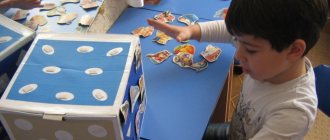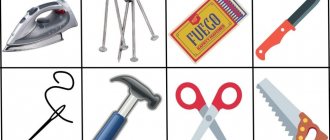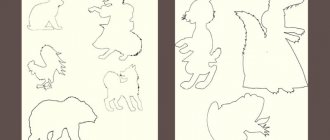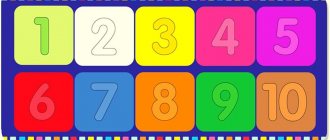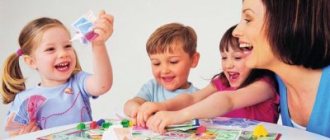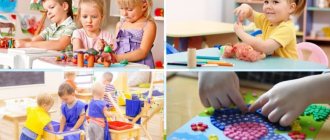Victoria Lysova
Card index of didactic games based on applications for preschool children
Junior group
"Merry little engine"
Goal: To develop the ability to pre-lay out (according to a certain sequence)
finished parts on a sheet of paper.
Material: Applique locomotive and parts .
Progress of the game: Consider the illustration of the locomotive in advance. Pay attention to the details of the locomotive (wheels, door, pipe, windows)
.
the application in front of the child , the teacher asks: What part is the train missing? Let's “fix”
the train and
“attach”
wheels to it.
"Colored Cups and Saucers"
Goal: Learn to select objects by color.
Material: Ready-made parts for cups and saucers (according to the number of children )
.
Progress of the game: Children are asked to choose a cup and saucer of the corresponding color and name the color. Or the child chooses a saucer and a cup to go with it.
"Funny Beads"
Purpose: To learn to use glue carefully: spread a thin layer of it with a brush on the back side of the figure to be glued (on a specially prepared oilcloth)
; apply the side coated with glue to a sheet of paper and press tightly with a napkin.
Material: Circles cut out of colored paper in different colors; finished craft.
Progress of the game: We provide the child with a finished craft and ask him to assemble the circles in the same sequence. And glue the beads.
“Show me the same ball”
Goal: To introduce children to the art of applique , to develop interest in this type of activity.
Material: Multi-colored balls.
Progress of the game: The teacher puts balls on the table and mixes them, selects one ball and asks the child to find the same one. For example, “I take a green ball, and you show me the same ball.”
.
"Color Path"
Goal: To consolidate knowledge of the shape of objects and their colors.
Material: Large multi-colored circles cut out of colored paper, as well as small squares. Lays out a multi-colored path. The distance between circles is 50 cm.
Progress of the game: The teacher shows and gives the child a card , for example, green, the child finds a green circle and places a card of the same color .
Middle group
“Collect animals from geometric shapes”
objects depicted in (birds, animals, flowers, insects, houses, both real and imaginary) from ready-made forms.
Material: Geometric shapes, animal cards .
Progress of the game: Children are asked to choose a card of any animal and use geometric shapes to assemble the animal.
"Magical Animals"
Goal: To foster interest in the application .
Material: Animal cards , geometric shapes (small shapes)
.
Progress of the game: Children are invited to choose a picture of any animal and decorate it with geometric shapes.
"Funny nesting dolls"
Goal: Continue to develop children's in visual arts.
Material: Pictures of nesting dolls , colored strips long and short and glue.
How to play: Children are asked to choose card and decorate it with long and short stripes.
“Make objects from strips”
Goal: To develop the ability to create images of different objects from stripes (fence, bench, ladder, tree, bush, etc.)
Material: Strips of different lengths, item templates.
Progress of the game: Children are invited to choose any template and lay out an outline from the stripes.
"Decorate the Christmas tree"
Goal: To teach to be friendly when evaluating the work of other children .
Material: Cone made of colored paper, geometric shapes of different sizes.
Progress of the game: Children are asked to choose a cone (Christmas tree)
and decorate it with different geometric shapes.
Senior group
"Let's decorate the mittens"
Goal: To develop aesthetic perception, teach to contemplate the beauty of the world around us.
Material: Ready-made mittens, geometric shapes, strips of different lengths.
Progress of the game: The teacher invites the children to take and decorate the mittens with geometric shapes and stripes.
"Collect transport"
Goal: To teach to convey in an image not only the basic properties of objects (shape, size, color)
.
Material: Ready-made geometric shapes of different sizes.
Progress of the game: Children are asked to choose geometric shapes and assemble vehicles.
"Make a Clown"
Goal: Improve visual skills and abilities.
Material: Geometric shapes of different sizes.
Progress of the game: Children are invited to choose geometric shapes and make a cheerful clown.
"Fairytale vases"
Goal: To encourage the creation of subject and subject compositions, supplementing them with details that enrich the images.
Material: Ready-made vases, circles.
Work program “Application” (middle group)
arouse interest in various buildings located around the kindergarten (houses in which the child and his friends live, school, cinema);
attract children's attention to the similarities and differences of different buildings, encourage them to independently identify parts of the building and its features; consolidate the ability to notice differences in buildings that are similar in shape and structure (shape and size of entrance doors, windows and other parts);
encourage children’s desire to depict real and fairy-tale buildings in applications;
organize a visit to the museum (together with parents), talk about the purpose of the museum;
develop interest in visiting puppet theaters and exhibitions;
consolidate children's knowledge about books and book illustrations; introduce the library as a storage center for books created by writers and poets;
introduce works of folk art (rhymes, fairy tales, riddles, songs, round dances, chants, products of folk arts and crafts);
cultivate a caring attitude towards works of art.
Visual activities
continue to develop children’s interest in visual arts; evoke a positive emotional response to the cut and paste offer;
continue to develop aesthetic perception, figurative ideas, imagination, aesthetic feelings, artistic and creative abilities;
continue to develop the ability to examine and examine objects, including with the help of hands;
enrich children's ideas about fine art (illustrations for works of children's literature, reproductions of paintings, folk decorative art, small sculpture, etc.) as the basis for the development of creativity; teach children to identify and use means of expression in application;
continue to develop the ability to create collective works in application;
strengthen the ability to maintain the correct posture: do not hunch over, do not lean low over the table; sit freely without straining; teach children to be neat: keep their work place in order, clear everything from the table after finishing work;
teach to be friendly when evaluating the work of other children.
Application
cultivate interest in the application, complicating its content and expanding the possibilities of creating a variety of images;
develop the ability to hold and use scissors correctly; teach cutting, starting with developing the skill of cutting in a straight line, first short and then long strips; learn to compose images of different objects from stripes (fence, bench, ladder, tree, bush, etc.); learn to cut round shapes from a square and oval shapes from a rectangle by rounding the corners; use this technique to depict vegetables, fruits, berries, flowers, etc. in appliqué;
Card index of didactic games for the younger group
Progress of the game
: Children need to choose objects and create their own still life.
Game "Finish the picture."
Didactic task:
identify the level of formation of perception and definition of an object behind its parts, be able to complete it; develop fantasy and imagination.
Materials and equipment:
pictures with partially drawn objects (bunny, Christmas tree.)
Progress of the game:
children need to recognize the object, fill in the parts that are missing, and color.
Game "Guess the time of year"
Didactic task:
consolidate children's knowledge about seasonal changes in nature, about the color scheme corresponding to the seasons.
Materials and equipment:
paintings typical of autumn, summer, winter, spring; Dunno doll.
Progress of the game:
The teacher holds Dunno in his hands and says that he came to visit me and told me that he forgot what the seasons are. He asks us to help him remember. The teacher asks the children what time of year it is now, and how you can find out this or that time of year. Then he listens to the answers, praises them if they have any difficulties, and reminds them with leading questions what is typical for each season. Dunno says thank you and leaves, and the teacher invites the children to play the game “Guess.” The children sit in a semicircle on the carpet, and the teacher shows them the pictures and asks them to name the season depicted. The game ends with: drawing your favorite season; exhibition of children's works in the reception room (Trofimova M.V., Tarabarina T.I. Both study and play: fine arts).
Game “Unusual Drawings” Didactic task :
develop the child’s imagination, fantasy and creative perception.
Materials and equipment:
semolina; plates according to the number of children.
Progress of the game:
The teacher says: “Children, today we had semolina porridge for breakfast. It is very tasty, healthy and a must-eat. Do you know that semolina porridge is not only eaten, but also used to create unusual paintings.” The teacher invites those who wish to draw such pictures. Children sit down at the table, and the teacher shows how to draw the sun, rain, circles, grass, fancy patterns, etc. on semolina with your fingers. The game ends: by photographing the resulting paintings; helping the teacher with cleaning. (Prokofieva A.G. Educational games for children.)
Game “What is red?”
Didactic task:
consolidate knowledge of primary colors; teach children to select red objects among objects of different shapes and colors.
Materials and equipment:
Katya doll, objects of different colors.
Progress of the game:
The teacher places objects of different colors (vegetables, dishes, pencils, etc.) along the edge of the table. The doll Katya comes to visit the children. She wants to match her red bow with objects of the same color. Children come up one at a time and name the object and its color: red tomato, red pencil, etc. If the answer is correct, the Katya doll nods her head approvingly, and the child puts the object in her purse; if the answer is incorrect, then Katya turns away.
MAGAZINE Preschooler.RF
Game techniques in the system of teaching applications to children of senior preschool age with general speech underdevelopmentOne of the main problems of education is the comprehensive and harmonious development of a person, his abilities and talents. In this complex process, the artistic development of preschool children represents the first stage, and it occurs by introducing the child to art, various types of artistic activities, among which applique occupies an important place, being a type of decorative and applied art.
Among the tasks facing a preschool institution, an important place is occupied by the task of preparing children for school. One of the main indicators of a child’s readiness for successful learning is correct, well-developed speech. The timely development of speech rebuilds the child’s entire psyche, allowing him to consciously perceive the phenomena of the surrounding world.
However, the success of children's aesthetic development and speech development largely depends on the nature of the pedagogical guidance of this type of activity. Of great importance is the use of optimal teaching methods and techniques that correspond to the specifics of visual activity and the age characteristics of children.
A necessary way to improve the methodology for guiding children's visual activities is to use gaming techniques that are specific to teaching preschool children. We believe that in relation to guiding the visual activities of children with general speech underdevelopment, the need to use gaming techniques has a special basis, which lies in the interrelationships of play, artistic creativity and speech development.
In a number of psychological studies conducted under the leadership of A.N. Leontyev and A.V. Zaporozhets, it was discovered that such mental processes as sensation (G. V. Endovitskaya), perception (Z. M. Boguslavskaya), memory (L. I. Zinchenko), attention (Z. M. Istomina), imagination (G. D. Lukov
O.M. Dyachenko, N.N. Palagin), thinking processes (A.V. Zaporozhets, Ya.Z. Neverovich), proceed most successfully in the game.
All researchers explain the educational effect of the game by the pronounced interest of children in the game. The closeness of play and artistic activity, as varieties of creativity, is manifested in the commonality of the leading mental processes that underlie them (imagination, feelings). It is known that these processes most easily arise and develop in game conditions. This provides grounds for using playful moments in guiding children's visual activities in order to activate imagination and feelings.
The fact that children easily learn “playfully” was noticed and proven by the great teacher K.D. Ushinsky, E.I. Tikheyeva, E.N. Vodovozova. Much credit for the development of game-based teaching methods belongs to E.A. Florina, N.P. Sakulina, R.I. Zhukovskaya, Z.M. Boguslavskaya, T.S. Komarova, etc.
G.G. paid great attention to the use of gaming techniques in visual arts classes. Grigorieva. In her opinion: “Game techniques in optimal combination with other teaching methods and techniques have a beneficial effect on the development of the individual, her creative potential, and artistic abilities...” .
To develop children’s speech in visual arts classes, various techniques are used: showing an object, showing depiction techniques, verbal explanation, examining an object, analyzing work, commenting on actions, using an adult’s speech as a model, etc. The artistic word is widely used in visual arts classes. It arouses interest in the topic, the content of the image, and helps to draw attention to children's works. The unobtrusive use of artistic words during the lesson creates an emotional mood and enlivens the image. It should be noted that the simultaneous use of several techniques in a lesson is very effective, for example, a combination of verbal explanation with demonstration of image techniques or with children reproducing their images (moving a brush without glue - on paper).
For correctional purposes, the work should be performed in small parts. The task is divided into two or three parts. This division ensures that the explanation alternates with the children doing the work. Switching types of activities increases children's performance, delays fatigue, helps them get involved in activities on time, and normalize its pace. And the correctness of the children’s work depends on this.
The specifics of the structure of the lesson are determined by the psychological characteristics of children with general speech underdevelopment - their rapid fatigue and distractibility. If a task must be completed in one sitting, children may miss some links in the work. Therefore, the task for visual activity is not explained in its entirety, but in parts, in several steps. This is especially useful for developing attention to speech and regulation of actions. Children must learn to understand from the explanation what can be done and what cannot be done yet. And not only understand, but also fulfill these requirements: restrain desires, wait patiently, start and finish at the same time, etc.
Both in mass kindergartens and in groups for children with speech impairments during visual arts classes, there is a close interweaving of children’s play and speech into it. Children “complete” with words what they cannot depict. These facts were noted in the studies of N.P. Sakulina, V.S. Mukhina, E.A. Flerina.
Teaching children through play is the basis of the proposals proposed by E.A. Flerina play exercises leading to consolidation of hand movements available to children: vertical, horizontal, circular. They give the drawn (pasted) object movement (the car is moving), based on the drawing (appliqué) they create a whole plot with the help of speech, animate and verbalize the objects, conveying their dialogue with onomatopoeia and accessible words. In her work “Aesthetic Education of a Preschooler” E.A. Flerina writes: “... the child feels the immediate quality of his speech, sometimes he looks for a “better” word , notices that it “came out well” , having found a rhyme for the line, he feels his luck, and this is his makes me happy."
What are the specifics of game-based teaching methods? By a system of game teaching techniques, we understand a set of techniques characterized by common essential features (the presence of game actions, an imaginary situation and an orientation towards solving didactic problems), classified in a certain way and included in the modern methodology for guiding children's visual activities.
On the one hand, like any techniques, they should be aimed at solving didactic problems. On the other hand, by their nature they should be as similar as possible to a real game and possess its essential features. This is all the more important because, unlike “real” free play, the game is offered in class by the teacher. Therefore, one of the signs of a gaming technique should be a gaming task.
The game task in these techniques is a unique formulation, defining the goal of the upcoming game actions. For example, the teacher says to the children: “Let’s build a house for the bear” or: “Let’s invite Parsley to visit” ; “Think about how you can help the bunny cross the river .
In the process of using a gaming technique, the number of gaming tasks may increase. Thus, the development of the game concept occurs.
Sometimes the teacher limits himself only to setting up a game problem, and then the usual educational work takes place during the lesson. It turns out that the children were “promised” a game, but the game did not take place. This happened because such a gaming technique did not contain the most important thing - the gaming actions through which any game is played. Therefore, game actions are an indispensable, one of the most important features of game teaching methods. With their help, a game task that is interesting for children is solved. So, to help the bunny cross the river, children make boats, “put” bunnies in them, “float” along the river, and “climb out” to the shore. Boats with “crooked sails” “hares don’t want to get into them . Children “repair” such boats, etc.
In cases where children are captivated by the events taking place in class, when they have a certain amount of knowledge and impressions about a given phenomenon, they themselves can set new tasks, come up with game actions and ways to carry them out.
Thus, gaming techniques are ways of jointly (teacher and children) developing a plot-game concept by setting game tasks and performing appropriate game actions aimed at teaching and developing children.
The teacher must remember that the content of game tasks and game actions must correspond to the children’s knowledge of the environment and their interests. Otherwise, the children's interest in the lesson is of a superficial, momentary nature, determined by the novelty of the paraphernalia or the unusualness of the game situation itself.
When developing game techniques, it is important to think not only about the content and logic of game actions, but also about their correspondence to the logic and meaning of real life situations. Otherwise, these techniques are far-fetched and unnatural. The more varied the content of the game actions, the more interesting and effective the gaming technique will be. Therefore, educators, when inventing them, should focus on the content of relevant life situations and the behavioral characteristics of humans and animals. If toys (substitutes) representing inanimate objects are used in gaming techniques, you should know the features of their use in real situations.
Thus, each game technique must have a game task and game actions. Their content is invented by the teacher, but always taking into account the children’s knowledge of the environment and their interests. The content, quantity, variety, and logic of game tasks and actions depend on this. If this condition is not taken into account by the teacher, then the child actually does not accept the play situation offered by the adult, soon loses interest in it, and the play influence on children is ineffective.
It is very important that the teacher is able to create truly playful relationships, without diluting the essence of the game with excessive didacticism. It’s sad when the teacher hastily and dryly says: “Children, a bear has come to us (at the same time she brings it from behind the door). He will have guests. He wants us to prepare him a treat . This exhausts the gaming technique. As a result, not only the essence of the game is lost, but the moral meaning of the situation is distorted.
For children with general speech underdevelopment, it is most important to conduct joint-individual activities in a small group. Each child is a participant in the activity, performs his or her assigned part of the overall work individually, and at the final stage it becomes part of the overall composition. Coordination of the actions of the participants in the work is carried out at the beginning - at the planning stage and at the end, when it is necessary to summarize the result. In subgroup classes, in contrast to frontal ones, each child has more opportunities for verbal expressions.
Correct guidance of the visual activities of children with general speech underdevelopment can only be carried out as a result of studying and knowing age-related and individual characteristics. Along with conducting frontal classes, it is absolutely necessary to use individual forms of classes with those students who especially need it. When cultivating interest in applications, you should be especially attentive to each child, be able to help him, give the necessary instructions, support the desire to do a good job and objectively evaluate his efforts.
Classes in visual arts, including appliqué, provide great opportunities for an individual approach. During the lesson, the teacher can approach each child, look at his work, give advice, guide the development of his creative idea and help in mastering technical skills.
As a result of the above, the following conclusions can be drawn:
- Acting as a specific figurative means of understanding reality, the application contributes to the manifestation of mental and speech activity of children, the development of concepts and ideas about the world around them, and the development of creativity
- in the process of application, special correctional tasks for the development of children’s speech are solved, the vocabulary is enriched, spoken language is improved, the appearance of coherent speech is prepared, etc.
- gaming techniques in optimal combination with other teaching methods and techniques have a huge impact on the creative development of children, form aesthetic feelings and ideas, develop imaginative thinking and imagination
- the use of commentary speech has a great influence on the development of speech perception, contributes to a more clear expression of the need for communication, speech activity based on accumulated speech means, and also leads children to understand a certain sequence of actions through a story and can be considered as a preparatory stage in learning to tell stories
- Applique classes provide ample opportunities for studying the characteristics of children and implementing an individual approach to each child, which contributes to the development of not only their artistic abilities, but also attention, observation, perseverance and will. The formation of these qualities is an essential condition for preparing a child for school and for the full development of the individual.
| Next > |
In connection with the expansion of the child’s knowledge about such properties of objects as shape, structure, size, and their spatial arrangement on paper, application tasks become more complicated. This concerns the design of objects, solving more complex compositional and coloristic problems in the design of works. The teacher teaches children to more accurately cut and paste simple shapes, based on a square, rectangle, or triangle. They can be used when composing ornamental compositions to decorate a scarf, plate, rug, path, and also display objects such as cubes, scarves, scarves, etc. Then the children are taught to cut out individual parts and assemble more complex objects from them (house, birdhouse, gate), and also combine them with each other in size (the house is large, and next to it is a gate, they are lower than the house).
In applications, children should be able to combine compositions by color, by methods of spatial arrangement on the surface of a sheet of paper of a certain format, which makes it possible to perform tasks of a different nature (subject, thematic and ornamental), differentiate specific tasks for each of them in the process of thinking about the future image, its cutting and pasting.
Before teaching preschoolers how to cut with scissors, it is necessary to strengthen their ability to lay out and paste ready-made shapes using the example of creating patterns from geometric or plant elements (one or two lessons at the beginning of the school year). So, you can invite the children to decorate a scarf or an apron for a doll with patterns, giving them the opportunity to independently choose a blank according to shape, color, select elements for decoration, and arrange them in their own way by color and location. If the baby has chosen a white square to decorate it in the form of a scarf, then he can take small colored squares and place them in the corners of the main workpiece. Alternating red and blue shapes will look good between the squares. When a child takes a stripe - a red scarf - for decoration, the teacher helps him rhythmically repeat the squares placed on the corner along the entire length, combining green and yellow tones (white and black; black and green).
To make such a choice, you must have in advance options for blanks and individual elements of different colors and sizes to compare them when creating an ornament. The teacher helps children in choosing a background, a pattern, varying figures in number, shape, color, and rhythm. The figure shows options for applications of varying degrees of difficulty. Children independently combine squares of various sizes and colors, as well as triangles and circles, based on the proposed motives.
Decoration with patterns of scarves, scarves, plates
At the beginning of the lesson, the teacher gives verbal instructions. For example, if a child has chosen a scarf (square base) for the exercise, then he is asked to use a combination of large and small elements (squares of a different color) or complement the pattern with triangles. To decorate a scarf (triangle), it is better to take circles and attach triangles between them. And children can decorate round plates and trays with an ornament of small circles, alternating them by color, or build another patterned composition from them.
When children master the techniques of laying out and gluing forms, their attention is focused on the techniques of using scissors when cutting out elements for appliqué. This process requires significant effort, attention and will. To make it easier, the teacher initially trains the child in cutting narrow strips across with uniform movements of scissors, performing a game task: cutting out tickets for playing “theater”, “circus”, checks for playing “shop”, coupons for playing “hospital”, travel tickets for playing “bus”, etc. The game form of cutting results increases the child’s interest in this process; in a relaxed play environment, he more easily learns how to use a new tool, adapts his movements to learn how to operate scissors. Children should definitely be given well-designed scissors so that their arms move easily and do not create additional difficulties.
The teacher observes the work of each child, provides him with timely assistance, encourages his efforts, supports the desire to learn how to correctly, beautifully cut out shapes (so that their contours are smooth and not frayed).
As an exercise for the hands, it is necessary to give the children tasks that require the completion of several identical cuttings. In this case, the movements are consolidated and improved. For this purpose, you can use ornamental structures, as well as object images consisting of several homogeneous parts. For example, when cutting out windows of a two- or three-story house, take a strip of paper of a certain length and width and cut it crosswise into several parts at an equal distance from each other. They are glued onto a rectangle, observing the rhythm of the arrangement: at designated intervals in one, two or three rows (corresponding to the number of floors of the house).
In the same way, appliqués are made for bus or trolleybus windows, as well as for a festive garland of flags. Here you need to alternate the shapes by color and create a bright sound for the decoration. Therefore, the teacher prepares multi-colored stripes in advance, and the children choose the brightest ones that they like and learn to alternate them when gluing them onto a background like a garland or on a stand using flagpoles of different heights, or on sticks, etc. The possibility of interpreting the content of the application is emphasized when the wording of the task: “Holiday flags”, “The flags that we saw in the square”, “A festive garland of multi-colored flags”.
Different types of flags
In subsequent appliqué classes, children are taught to cut out a rectangular shape more accurately and differentiate between a rectangle, a square, and a strip. The basis for cutting out these shapes is a strip of paper of different lengths and widths. Thus, a rectangle is obtained by cutting a strip of 3x12 cm into two parts, and dividing each of them in half again allows you to get two squares, which are then glued to decorate the end of a towel or scarf.
You can change the size of the elements or give them different positions, for example, place large and small squares placed on the corner in a row, alternating them also by color (red and green figures on a white towel background; blue and orange; red and yellow). This task requires the child to comply with the following conditions: cut out several identical shapes, independently adjust their number depending on the construction of the pattern, combine elements by size and color. Providing independence in choosing the background color and blanks for parts of the decoration allows children to take a creative approach to creating an ornament and use different options for its interpretation.
To consolidate the ability to depict squares and make various combinations out of them, appliqués are grouped from individual parts like a mosaic. Each child is given multi-colored strips of the same size, from which he receives squares, and combines them in the form of patterns or object images on backgrounds of different shapes and colors. Children complete such mosaics independently in their free time. To do this, a separate corner is organized in the group room - an area where the materials necessary for work are placed. Their color and diversity encourage the child to create a panel for a doll’s corner, decorate an apron or dress with a pattern, prepare a greeting card for a holiday, etc.
Mosaic applique of multi-colored squares
From a square, by cutting it in half diagonally with a continuous movement of scissors, two triangles are obtained. Typically, children learn this technique quite easily and quickly. But, despite this, it must be reinforced in several lessons, maintaining the preschooler’s interest in the image process and its result. This is achieved by selecting interesting tasks: “Kerchiefs for nesting dolls”, “Huts in the forest”, “Christmas tree”.
Along with homogeneous parts, combinations of rectangular, square, and triangular shapes are also used in applications. This is how fish are cut out and pasted, combining a square (body) placed on a corner and a triangle (tail) or two triangles - a large one and a smaller one. To achieve greater resemblance to the image of a fish, additionally glue on large eyes, stripes or scales of colored paper. You can make an especially elegant applique on the theme “Aquarium”, where on a blue or blue plane children place large and small fish with a triangular or square body in yellow, red, orange, gray in combination with green algae, pebbles at the bottom, etc. To obtain such a composition, the teacher prepares a background with pasted silhouettes of algae, stones, shells, and the children glue fish of different colors and sizes between them. Here, each child can show his creative activity: change the direction of movement of the fish in his own way, make them larger, smaller, use decorative stickers (stripes, circles-scales).
Techniques for cutting triangles and fish variants from squares and triangles
Fishes in an aquarium
